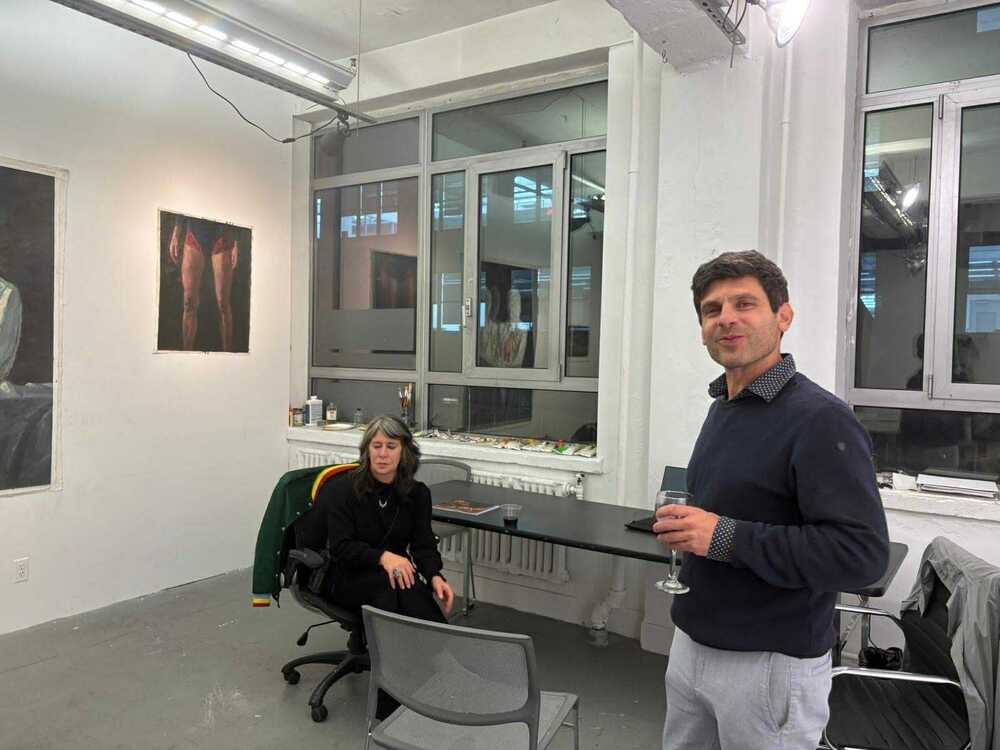site.bta Artist Radoslav Maglov: New York Is a Welcoming Stage for Bulgarian Contemporary Art


Amid a New York art residency that started in October, Bulgarian artist, researcher, and theorist Radoslav Maglov says New York is a welcoming stage for contemporary Bulgarian art. Maglov lives and works in Sofia. His artistic practice spans video, installation, sculpture, and painting. In 2023, he earned a PhD from the National Academy of Art in Sofia.
Earlier this month, Maglov presented a selection of works from his projects “Wired/Weird” (2021) and “Spare Eye” (2024) during the Open Studio Days at the Elizabeth Foundation for the Arts (EFA) in New York. His participation was supported by the American Foundation for Bulgaria, under the patronage of Ted Vassilev, marking the beginning of a new partnership between the foundation and EFA.
“This event is part of my artist residency at the Elizabeth Foundation for the Arts, which began in early October,” Maglov told BTA’s BG World. “The Open Studio Days took place only a few weeks after my arrival in New York and naturally marked the start of my stay here.”
Maglov is the first Bulgarian visual artist invited under this new initiative. “It’s both an honor and a responsibility,” he said, noting that the residency continues for three months in 2025 and another six months in 2026 — time he plans to use to develop the conceptual and research dimensions of his practice.
Attendance at the Open Studio Days was “truly impressive,” he said, with moments when more than twenty people crowded into his 35-square-meter studio. Visitors included curators, gallery directors, and art program managers, as well as members of New York’s Bulgarian community. Among them were Elisaveta Mihova and members of the American Foundation for Bulgaria, whose ongoing philanthropy supports Bulgarian culture abroad. Maglov also credited the Consulate General of Bulgaria in New York, and particularly Consul General Angel Angelov, for their consistent efforts to promote Bulgarian culture in the city.
Maglov said the conversations during the event confirmed that the themes he explores — the body, liminality, and the space between the visible and the conceptual — resonate strongly with the New York scene. “The most valuable thing was to see people engaging deeply with the work,” he said. “When someone stops, asks a question, or shares their interpretation, that’s when communication has truly happened. Art begins to generate new meanings, new perspectives that didn’t exist before the encounter between artwork and viewer.”
The artist presented pieces from “Wired/Weird” and “Spare Eye,” two projects that examine related concepts through different media. “Wired/Weird” features paintings that explore the paradoxes of social connectedness through a phenomenological lens — a dialogue between the biological and the social that shapes new forms of identity and perception. “Spare Eye” consists of graphite drawings on the reverse side of photographic paper, created through a slow, almost meditative process that evokes photographic development. “The drawings inhabit a gray zone between the emergence of an image and its interpretation in the viewer’s mind,” he explained.
Combining the two projects, he said, creates “a broad continuum of artistic research — from the figural and material qualities of ‘Wired/Weird’ to the almost spectral sensitivity of ‘Spare Eye.’ It’s an attempt to activate the body as a resource for thought and to use visual art as a language that leaves room for interpretation between recognition and meaning.”
Maglov described the EFA residency as a rare opportunity to connect with artists who share an “analytical and process-oriented approach” to contemporary art. “You can see what’s truly leading in art right now — not as a trend, but as a way of thinking,” he said. “For me, it was important to find that the themes I work on — the body as a resource for interpretation, the blurred line between organic and synthetic, and vulnerability as an aesthetic and philosophical category — are recognizable internationally.”
When asked how he chooses his artistic medium, Maglov explained that the concept always dictates the form. “The medium is a tool through which thought and communication are realized,” he said. “Whether it’s an installation, a painting, or a video, it depends on how best the idea can be expressed.”
He cited artists like Andy Warhol and Man Ray as examples of creators who moved fluidly between media, seeking new expressive possibilities. “In my practice, each medium offers a different kind of experience — video unfolds in time, installation engages the body and space, and painting often invites introspection.”
Summing up his philosophy, Maglov offered two short statements that encapsulate his artistic worldview: “Art is not a one-sided act. Art is realized through sharing.”
“Showing my work here, in New York — a vast jewel adorned with skyscrapers like shining diamonds, a place where art constantly reinvents itself — is both an honor and an opportunity to engage in dialogue with people and the professional community,” he said. “It’s exciting, but also challenging. When you have a platform to be heard, it matters deeply what you say — and how you say it.”
Maglov believes that while New York is open to Bulgarian contemporary art, there is still a lack of institutional support at home. “The role of Bulgarian artists and the importance of contemporary art for our cultural identity are not yet fully recognized,” he said. “We need more platforms and funding to strengthen Bulgaria’s presence on the international scene.”
Looking ahead, Maglov plans to continue developing new works based on themes of uncertainty and fluid presence. Two Sofia galleries are scheduled to exhibit the pieces created in New York in 2026, alongside his ongoing postdoctoral research and a planned solo exhibition back in New York.
/NF/
news.modal.header
news.modal.text